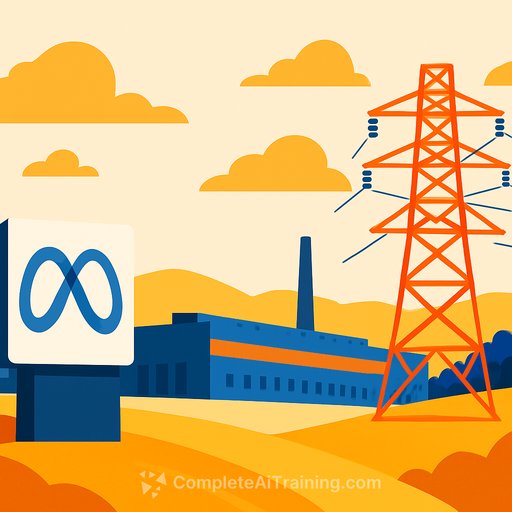In rural Richland Parish, northeastern Louisiana, Meta is investing $10 billion to build a massive data center complex that could become the largest in the world. Spanning over 4 million square feet—bigger than Disneyland—this facility, named “Hyperion,” aims to power Meta’s most ambitious AI projects. The site, once farmland and floodplain, was chosen for its vast land availability and proximity to the Haynesville Shale gas field, providing access to natural gas for energy needs.
Construction began in December on nine buildings that will house banks of servers designed to train open-source large language models. Meta’s CEO Mark Zuckerberg projects the complex will eventually consume the energy equivalent of 4 million homes and could reach up to 5 gigawatts of computing capacity. This initiative follows Meta’s push to regain footing in the AI race after earlier setbacks and heavy investments in other tech ventures.
Energy Demands and Infrastructure
The data center’s energy requirements are unprecedented. To support Hyperion, Entergy, the regional utility, will build three new gas-fired turbines totaling 2.3 gigawatts—marking the first major power plant expansion in decades for the region. Meta will cover the initial power costs for these plants for 15 years and contribute to adding 1.5 gigawatts of solar and battery storage in Louisiana.
This scale of energy consumption sparks concerns among local residents, environmentalists, and industries alike. There are fears about rising utility rates and the impact on the electric grid, which has already experienced blackouts due to demand spikes. Some environmental groups question the reliance on natural gas, especially as the state has redefined natural gas as green energy, enabling the project to qualify under renewable energy goals.
Setting a National Template
The project has received regulatory approval faster than expected, signaling a possible model for future utility and data center partnerships across the U.S. Louisiana’s Public Service Commission greenlit the gas plant projects despite opposition from some commissioners and energy users, including major oil companies. The deal is seen as a test case for balancing large-scale economic development with energy infrastructure expansion.
Experts note that utilities are now gatekeepers for hyperscale data centers, weighing massive capital investments against risks like rate hikes and potential underuse if AI demand plateaus or becomes more efficient. The U.S. Department of Energy predicts data center electricity demand could triple by 2028, potentially accounting for up to 12% of national electricity usage.
Implications for Real Estate and Construction
- Land Use: Large data centers require extensive land, often in rural or economically depressed areas where land is affordable. This can drive industrial development in regions previously lacking such investment.
- Infrastructure Demand: The need for new power plants, transmission lines, and cooling resources will create construction opportunities but also raise questions about sustainable practices and resource allocation.
- Regulatory Environment: Accelerated approvals and special tax exemptions, as seen in Louisiana, suggest a trend toward incentivizing big tech investments, impacting local economies and real estate markets.
For developers and construction professionals, understanding these emerging demands is critical. Projects like Hyperion require coordination with utilities, environmental assessments, and long-term planning to accommodate energy and water needs. Additionally, these developments may increase demand for housing and commercial properties as workers relocate to support facility operations.
Balancing Growth and Sustainability
While Meta is investing heavily in gas-fired power, it has committed to expanding solar and battery storage to offset some emissions. However, supply chain constraints on turbines and concerns over grid stability highlight challenges in scaling energy infrastructure quickly.
Environmental advocates urge a cautious approach, recommending prioritizing renewable energy and flexible grid management over large-scale gas plant construction. The debate continues over whether current projections for AI-driven energy demand could result in overbuilding or if the need for power will keep rising.
Looking Ahead: National Trends
Data centers are concentrated in states like Virginia, Texas, and California, but new developments are moving into less urbanized areas with affordable land and access to utilities. Regions like the PJM Interconnection (covering Pennsylvania, New Jersey, Maryland, and others) are expected to see growth due to competitive power markets and infrastructure.
Construction and real estate professionals should watch for:
- Increasing rural industrial development opportunities tied to data center buildouts
- Utility partnerships and regulatory frameworks shaping project feasibility
- Environmental and community concerns influencing project design and approval
As these projects expand, they will impact local economies, resource management, and infrastructure demands, requiring strategic planning from all stakeholders involved in real estate and construction.
Conclusion
Meta’s Hyperion project in Louisiana marks a significant shift in AI infrastructure development, showcasing the scale of investment and energy consumption required for next-generation data centers. For professionals in real estate and construction, this signals new opportunities and challenges in rural industrial development, power infrastructure, and regulatory navigation.
Those interested in the intersection of AI, infrastructure, and construction can explore targeted training and resources to stay informed and competitive. Visit Complete AI Training for courses that cover AI's impact across industries and the evolving demands on infrastructure.
Your membership also unlocks:






